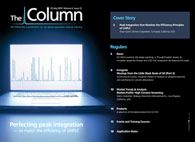The art of chromatography
This summer the National Gallery in London will host an exhibition demonstrating some of the ways that science has been able to shed new light on the history behind some of the Gallery's priceless works of art.

This summer the National Gallery in London will host an exhibition demonstrating some of the ways that science has been able to shed new light on the history behind some of the Gallery’s priceless works of art. The exhibition, Close Examination, is a partnership between the Engineering and Physical Sciences Research Council (EPSRC) and the National Gallery and explores the work of the gallery’s scientific department by presenting the stories behind more than 40 paintings in the collection.
An EPSRC-funded gas chromatography–mass spectrometer (GC–MS) has helped specialists in the gallery’s scientific department study the organic chemistry of old master paintings to understand how paintings were made and how they have changed over time. GC–MS has been used to study the characterization and composition of paint binding media, additions to paint media such as resins and the composition of old varnishes.
Ashok Roy, director of science at the gallery explained some of the challenges the department faces: “Firstly only tiny quantities of material are available for analysis as samples, plus the organic content can be very complex. In addition, these materials have generally changed over time so that analysis may be of degraded materials the results of which have to be translated into assessments of the original chemical composition when the painting was first produced.”
According to the organizers the partnership between the National Gallery and EPSRC highlights the contribution that science and scientists make in the world of art and shows the intellectual value that emerges when scientific and artistic traditions come together.
This story originally appeared in The Column. Click here to view that issue.
Detecting Hyper-Fast Chromatographic Peaks Using Ion Mobility Spectrometry
May 6th 2025Ion mobility spectrometers can detect trace compounds quickly, though they can face various issues with detecting certain peaks. University of Hannover scientists created a new system for resolving hyper-fast gas chromatography (GC) peaks.
Altering Capillary Gas Chromatography Systems Using Silicon Pneumatic Microvalves
May 5th 2025Many multi-column gas chromatography systems use two-position multi-port switching valves, which can suffer from delays in valve switching. Shimadzu researchers aimed to create a new sampling and switching module for these systems.
New Study Reviews Chromatography Methods for Flavonoid Analysis
April 21st 2025Flavonoids are widely used metabolites that carry out various functions in different industries, such as food and cosmetics. Detecting, separating, and quantifying them in fruit species can be a complicated process.

.png&w=3840&q=75)

.png&w=3840&q=75)



.png&w=3840&q=75)



.png&w=3840&q=75)












